7.2: Reference Angles
- Page ID
- 83152
The Special Right Triangles, \(30˚\)-\(60˚\)-\(90˚\) and \(45˚\)-\(45˚\)-\(90˚\), allow us to obtain exact values of the ordered pairs \((x, y)\) on a unit circle with standard angles \(30˚\), \(45˚\), or \(60˚\).
If we use symmetry across the \(y\)-axis and the \(x\)-axis, we can populate the known ordered pairs from QI into Quadrants II, III, and IV. Use the figures below to follow how this is done. To keep the pictures simple, \(30˚\) angles are marked, while \(45˚\) and \(60˚\) can be surmised by their larger magnitudes.
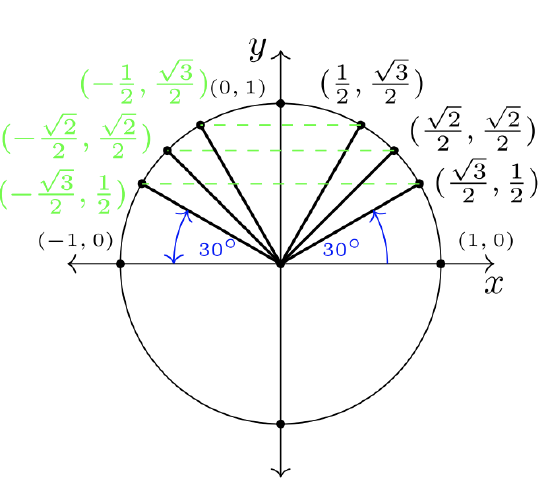
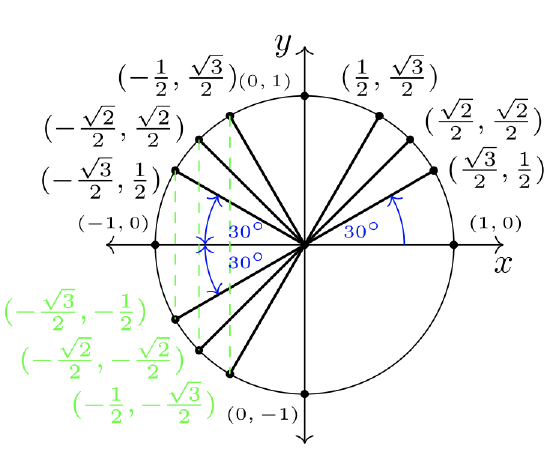
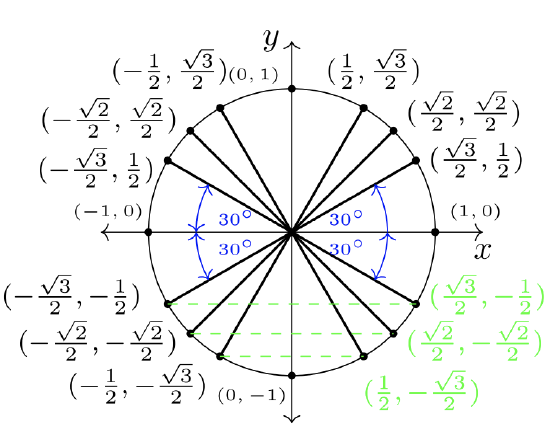
Notice the four \(30˚\) angles create a bow-tie look in Figure \(7.2.3\). These angles are called reference angles.
Let \(\theta\) be a standard angle. A reference angle, denoted \(\hat{\theta}\), is the positive acute angle between the terminal side of \(\theta\) and the \(x\)-axis.
The word reference is used because all angles can refer to QI. That is, memorization of ordered pairs is confined to QI of the unit circle. If a standard angle \(\theta\) has a reference angle of \(30˚\), \(45˚\), or \(60˚\), the unit circle’s ordered pair is duplicated, but the sign value of \(x\) or \(y\) may need adjustment, depending on the quadrant of the terminal side of \(\theta\).
The terminal side of a standard angle \(\theta = 225˚\) intersects the unit circle. State the ordered pair of the intersection.
Solution
The unit circle has radius \(r = 1\). Trigonometry weds algebra and geometry with visual sketches. We start with a sketch of the angle \(\theta = 225˚\). All standard angles begin on the positive-side of the \(x\)-axis. In which quadrant is the terminal side of \(\theta\)? That is, where does this angle come to a stop?
Where is the terminal side of \(\theta = 225˚\)? Since \(180˚ < 225˚ < 270˚\), the angle’s terminal side is in QIII.
The reference angle is computed by finding The difference between \(225˚\) and \(180˚\).
Note: The reference angle is never negative.
\(|225˚ − 180˚| = |180˚ − 225˚| = \hat{\theta}\)
\(45˚ = \hat{\theta}\)
In QIII, all ordered pairs \((x, y)\) are such that \(x < 0\) and \(y < 0\). Referring back to QI, using standard angle of \(45˚\) on the unit circle, the ordered pair \(\left( \dfrac{\sqrt{2}}{2} , \dfrac{\sqrt{2}}{2} \right)\) must be adjusted for negative \(x\) and \(y\) coordinates.
Answer The terminal side of \(\theta = 225˚\) intersects the unit circle at \(\left( −\dfrac{\sqrt{2}}{2} , −\dfrac{\sqrt{2}}{2} \right)\).
Tip: When a standard angle is greater than \(90˚\), use markers \(180˚\) or \(360˚\) to calculate the reference angle. Drawing a picture before computing is always recommended!
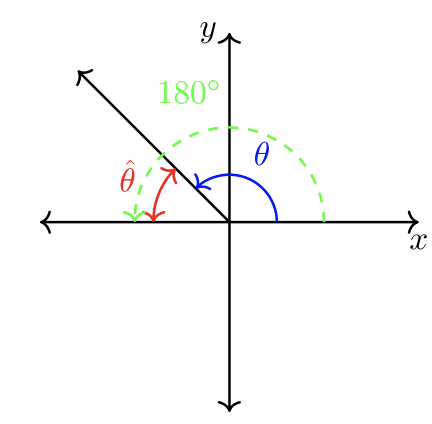
\(|180˚ − \theta| = \textcolor{red}{\hat{\theta}}\)
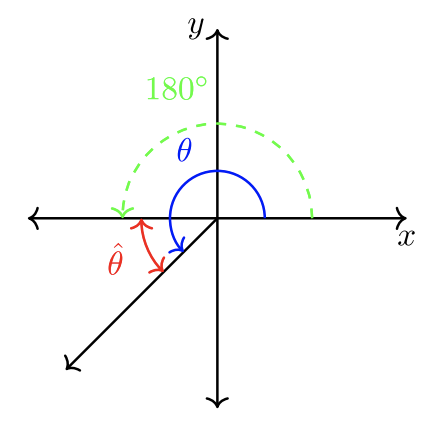
\(|180˚ − \theta| = |\theta − 180˚| = \textcolor{red}{\hat{\theta}}\)
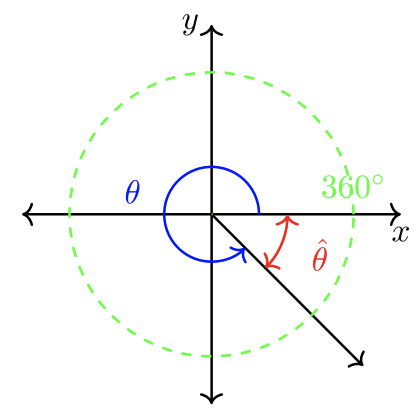
\(|360˚ − \theta| = \textcolor{red}{\hat{\theta}}\)
The terminal side of a standard angle \(\theta = −480˚\) intersects the unit circle. State the ordered pair of the intersection.
Solution
Negative angles rotate clockwise. Sketch \(\theta\). Find a positive coterminal angle: \(−480˚ + 360˚(2) = 240˚\) Then apply the tips above or analyze visually: \(|180˚ − 240˚| = |−60˚| = 60˚ = \hat{\theta}\)
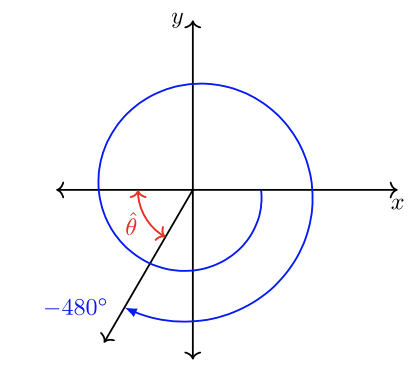
The ordered pair on the unit circle is \(\left(−\dfrac{1}{2} , −\dfrac{\sqrt{3}}{2} \right)\).
Try It! (Exercises)
For #1-10, state the reference angle, \(\hat{\theta}\), of the given standard angle.
- \(\theta = 210˚ \)
- \(\theta = 350˚\)
- \(\theta = 110˚\)
- \(\theta = 240.5˚\)
- \(\theta = 142.75˚\)
- \(\theta = −315˚\)
- \(\theta = −230˚\)
- \(\theta = 500˚\)
- \(\theta = 615˚\)
- \(\theta = −835˚\)
For #11-20, the terminal side of the given standard angle, \(\theta\), intersects the unit circle at a point. State the ordered pair of the intersection.
- \(\theta = 135˚\)
- \(\theta = 300˚\)
- \(\theta = −240˚\)
- \(\theta = −150˚\)
- \(\theta = 420˚\)
- \(\theta = 570˚\)
- \(\theta = 840˚\)
- \(\theta = −765˚\)
- \(\theta = −930˚\)
- \(\theta = 1560˚\)
For #21-28, a standard angle’s rotation is described in words. You are given several hints about its rotation. Note: a full revolution is \(360˚\) (counter-clockwise) or \(-360˚\) (clockwise). Find the measure of the angle described.
- An angle has a counter-clockwise rotation. The angle does not make a full revolution. The angle’s terminal side is in QIV. The reference angle \(\hat{\theta} = 30˚\).
- An angle has a counter-clockwise rotation. The angle does not make a full revolution. The angle’s terminal side is in QII. The reference angle \(\hat{\theta} = 20˚\).
- An angle has a clockwise rotation. The angle does not make a full revolution. The angle’s terminal side is in QIII. The reference angle \(\hat{\theta} = 10˚\).
- An angle has a clockwise rotation. The angle does not make a full revolution. The angle’s terminal side is in QII. The reference angle \(\hat{\theta} = 72˚\).
- An angle has a counter-clockwise rotation. The angle goes just beyond one full revolution. The angle’s terminal side is in QI. The reference angle \(\hat{\theta} = 55˚\).
- An angle has a counter-clockwise rotation. The angle goes beyond two full revolutions. The angle’s terminal side is in QII. The reference angle \(\hat{\theta} = 24˚\).
- An angle has a clockwise rotation. The angle goes beyond one full revolution. The angle’s terminal side is in QIII. The reference angle \(\hat{\theta} = 18˚\).
- An angle has a clockwise rotation. The angle goes beyond two full revolutions. The angle’s terminal side is in QIV. The reference angle \(\hat{\theta} = 39˚\).


